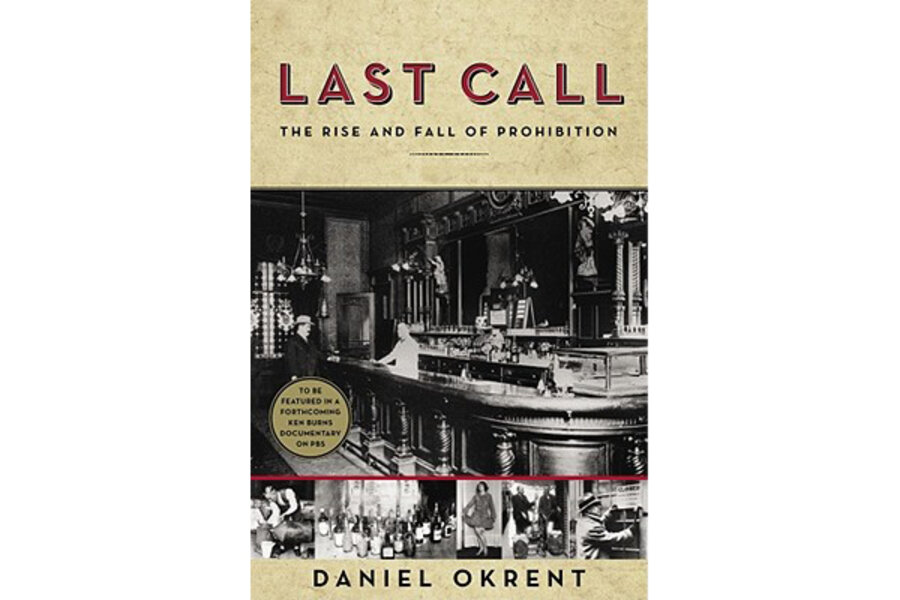Last Call
Loading...
Did you know that James Madison drank an entire pint of whiskey daily? Or that George Clinton, governor of New York, once served 261 bottles of alcohol at a dinner for 120 guests? How about the fact that in the 1820s, liquor was cheaper than tea in the United States, or that by 1875 one-third of all federal revenue came from alcohol? (All this consumption led an English visitor in 1839 to note, “I am sure the Americans can fix nothing without drink.”)
You undoubtedly do know that there was a backlash called Prohibition, which lasted from 1920 to 1933. And you have probably read in history books that it was considered a disaster. But did you know that one of its most famous enforcers, Eliot Ness, himself died an alcoholic? Or that, during Prohibition, it was permissible to sell an alcoholism “cure” called Colden’s Liquid Beef Tonic – although it was 53 proof (26 percent alcohol)? How about the fact that New York City had 32,000 illegal drinking establishments at the height of Prohibition?
Last Call, Daniel Okrent’s remarkable new history of Prohibition is packed with fascinating anecdotes from this flirtation with government-mandated sobriety. But Okrent, an elegant writer with a sense of humor (formerly the public editor of The New York Times), goes deeper. He shows that Prohibition was not just about alcohol. He explains with clarity and gusto how “a mighty alliance of moralists and progressives, suffragists and xenophobes” led to the ratification of the 18th Amendment. Without belaboring the point, he argues that the Prohibitionists – a motley group obsessively adhered around a single aim – provided “a template for political activism” still being followed a century later.
Okrent paints a convincing canvas of a tipsy America, with alcohol production “at the very moment of its death, the fifth-largest industry in the nation. Most hard drinking was done by men; unsurprisingly, the earliest proponents of Prohibition were their wives and those concerned with the welfare of women.”
Among the female activists’ many strange bedfellows were Protestant nativists who associated the consumption of alcohol with the great unwashed Roman Catholic masses of Eastern Europe and the Mediterranean. Much of their concern reeked of condescension. A muckraker in Chicago complained, “If a new colony of foreigners appears, some compatriot is set at once to selling them liquor. Italians, Greeks, Lithuanians, Poles – all the rough and hairy tribes which have been drawn to Chicago – have their trade exploited to the utmost.”
Racists – including the Ku Klux Klan – also agitated for Prohibition. One fervent Prohibitionist warned, “the grogshop is the Negro’s center of power.” It did not help that Jews were often the purveyors of liquor. The beer industry was largely controlled by Germans, which did not bode well as World War I gripped Europe.
But the ratification of the 18th Amendment – brought about by the bulldog Anti-Saloon League – proved to be a curse for the “drys.” Prohibition was rammed through by intimidating local and national politicians, but enforcement was lax and support tenuous. The laissez-faire attitude toward drinking emanated from the White House of Warren G. Harding, where could be found “trays with bottles containing every imaginable brand of whisky ... a general atmosphere of the waistcoat unbuttoned, feet on the desk, and the spittoon alongside.”
Enforcement through the Prohibition Department was, in Okrent’s words, “inept and venal.” There were only 1,500 federal agents, and slightly more than 50 boats to patrol 4,993 miles of coastline. In Boston, “four speakeasies were located on the same block as police headquarters.”
Okrent estimates that drinking declined by about 30 percent in the early years of Prohibition, but eventually Americans seemed to drink much more as alcohol became an underground industry.
Obviously, it could not last. Opponents of the War on Drugs will recognize the frustrating hallmarks: misspent money and wasted manpower, a legal system choked by petty cases.
By the time Franklin D. Roosevelt came into office, the nation had also tired of hectoring blowhards like the reformer William Jennings Bryan (mocked even by some fellow Democrats as “The Beerless Leader”). They also saw the thinly disguised racism that Prohibition had long masked. And once the Great Depression settled over the land, it became impossible to ignore the profit in a sales tax on alcohol. When Prohibition was finally repealed in 1933, just about everyone was glad.
Okrent treats both wet and dry causes with nuance, although his sympathies clearly lie with the former. “In almost every respect imaginable, Prohibition was a failure,” he writes. “It encouraged criminality and institutionalized hypocrisy. It deprived the government of revenue, stripped the gears of the political system, and imposed profound limitations on individual rights.”
Prohibition may have been a failure. But its story – as recounted by Okrent in “Last Call” – is popular history at its best.
Alexander Nazaryan is a writer and teacher in Brooklyn. He is working on his first novel.






